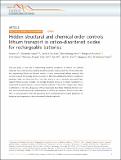Hidden structural and chemical order controls lithium transport in cation-disordered oxides for rechargeable batteries
Abstract
Structure plays a vital role in determining materials properties. In lithium ion cathode materials, the crystal structure defines the dimensionality and connectivity of interstitial sites, thus determining lithium ion diffusion kinetics. In most conventional cathode materials that are well-ordered, the average structure as seen in diffraction dictates the lithium ion diffusion pathways. Here, we show that this is not the case in a class of recently discovered high-capacity lithium-excess rocksalts. An average structure picture is no longer satisfactory to understand the performance of such disordered materials. Cation short-range order, hidden in diffraction, is not only ubiquitous in these long-range disordered materials, but fully controls the local and macroscopic environments for lithium ion transport. Our discovery identifies a crucial property that has previously been overlooked and provides guidelines for designing and engineering cation-disordered cathode materials.
Citation
Ji , H , Urban , A , Kitchaev , D A , Kwon , D-H , Artrith , N , Ophus , C , Huang , W , Cai , Z , Shi , T , Kim , J C , Kim , H & Ceder , G 2019 , ' Hidden structural and chemical order controls lithium transport in cation-disordered oxides for rechargeable batteries ' , Nature Communications , vol. 10 , 592 . https://doi.org/10.1038/s41467-019-08490-w
Publication
Nature Communications
Status
Peer reviewed
ISSN
2041-1723Type
Journal article
Description
This work was supported by the Robert Bosch Corporation, Umicore Specialty Oxides and Chemicals, and the Assistant Secretary for Energy Efficiency and Renewable Energy, Vehicle Technologies Office of the U.S. Department of Energy under Contract No. DE-AC02-05CH11231 under the Advanced Battery Materials Research (BMR) Program. The research conducted at the NOMAD Beamline at ORNL’s Spallation Neutron Source was sponsored by the Scientific User Facilities Division, Office of Basic Sciences, U.S. Department of Energy. Work at the Molecular Foundry was supported by the Office of Science, Office of Basic Energy Sciences, of the U.S. Department of Energy under Contract No. DE-AC02-05CH11231. The computational analysis was performed using computational resources sponsored by the Department of Energy’s Office of Energy Efficiency and Renewable Energy and located at the National Renewable Energy Laboratory, as well computational resources provided by Extreme Science and Engineering Discovery Environment (XSEDE), which was supported by the National Science Foundation grant number ACI-1053575.Collections
Items in the St Andrews Research Repository are protected by copyright, with all rights reserved, unless otherwise indicated.

